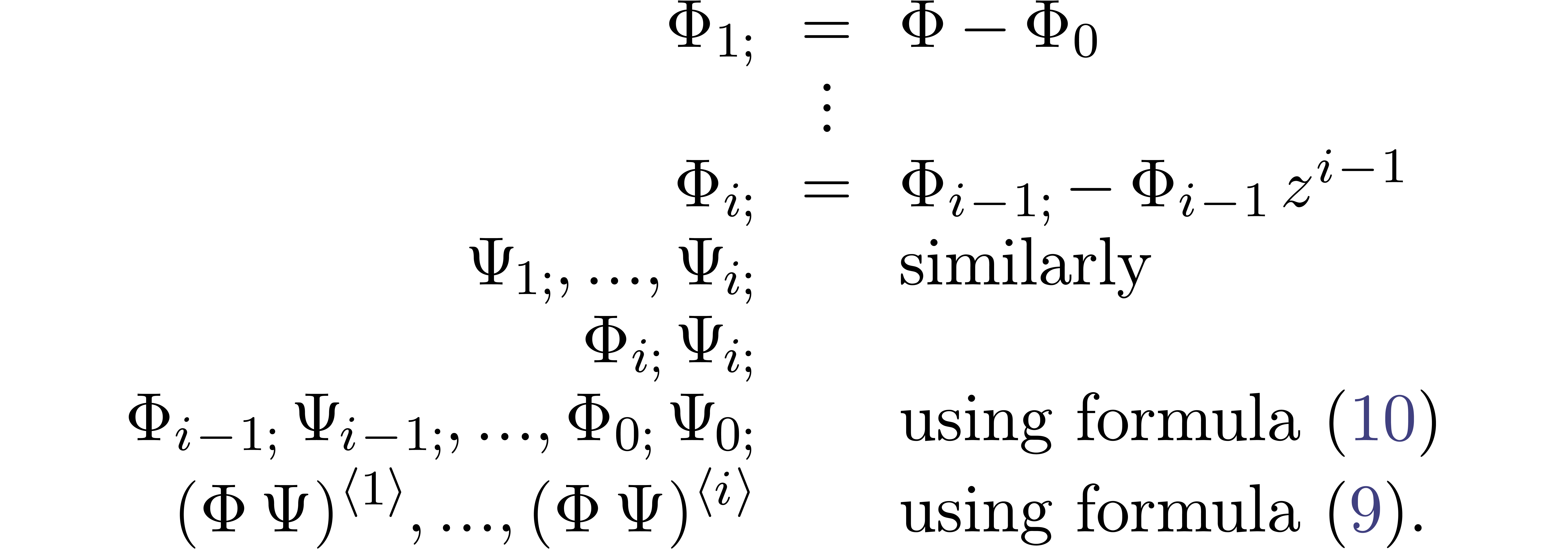From implicit to recursive
equations |
|
| August 30, 2018 |
|
 . This work has
been supported by the ANR-09-JCJC-0098-01
. This work has
been supported by the ANR-09-JCJC-0098-01
The technique of relaxed power series expansion provides an
efficient way to solve so called recursive equations of the form
|
Let  be an effective field of constants of
characteristic zero. This means that elements in
be an effective field of constants of
characteristic zero. This means that elements in  can be encoded by data structures on a computer and that we have
algorithms for performing the field operations of
can be encoded by data structures on a computer and that we have
algorithms for performing the field operations of  .
.
Let  be a column vector of
be a column vector of  indeterminate series in
indeterminate series in  . We
may also consider
. We
may also consider  as a power series
as a power series  . Let
. Let  be a column
vector of expressions built up from
be a column
vector of expressions built up from  ,
,
 and constants in
and constants in  using
ring operations, differentiation and integration (with constant term
zero). Finally, let
using
ring operations, differentiation and integration (with constant term
zero). Finally, let  be a finite number of
initial conditions. Assume that the system
be a finite number of
initial conditions. Assume that the system
 |
(1) |
admits a unique solution  . In
this paper, we are interested in the efficient computation of this
solution up to a given order
. In
this paper, we are interested in the efficient computation of this
solution up to a given order  .
.
In the most favourable case, the equation  is of
the form
is of
the form
where the coefficient  of
of  in
in  only depends on earlier coefficients
only depends on earlier coefficients  of
of  , for
each
, for
each  . In that case,
. In that case,

actually provides us with a recurrence relation for the computation of
the solution. Using the technique of relaxed power series expansions [Hoe02, Hoe07], which will briefly be recalled in
section 2.4, it is then possible to compute the expansion
 at order
at order  in time
in time
where  is the number of multiplications occurring
in
is the number of multiplications occurring
in  ,
,  is the total size of
is the total size of  as an expression, and
as an expression, and  denotes the complexity of relaxed multiplication of
two power series at order
denotes the complexity of relaxed multiplication of
two power series at order  .
Here we assume that
.
Here we assume that  is represented by a directed
acyclic graph, with possible common subexpressions. For large
is represented by a directed
acyclic graph, with possible common subexpressions. For large  , it was shown in [Hoe02,
FS74, Hoe03, LS16] that
, it was shown in [Hoe02,
FS74, Hoe03, LS16] that  , where
, where  denotes the complexity [CT65, SS71, CK91]
of multiplying two polynomials of degrees
denotes the complexity [CT65, SS71, CK91]
of multiplying two polynomials of degrees  .
More recently, it has been shown [Hoe14, Hoe07]
that we even have
.
More recently, it has been shown [Hoe14, Hoe07]
that we even have  . For
moderate
. For
moderate  , when polynomial
multiplication is done naively or using Karatsuba's method, relaxed
multiplication is as efficient as the truncated multiplication of
polynomials at order
, when polynomial
multiplication is done naively or using Karatsuba's method, relaxed
multiplication is as efficient as the truncated multiplication of
polynomials at order  [Hoe97, Hoe02].
[Hoe97, Hoe02].
One particularly important example of an equation of the above type is the integration of a dynamical system
where  is algebraic (i.e. does not
involve differentiation or integration). In that case, given the
solution
is algebraic (i.e. does not
involve differentiation or integration). In that case, given the
solution  at order
at order  ,
we may consider the linearized system
,
we may consider the linearized system

at order  , where
, where  stands for the Jacobian matrix associated to
stands for the Jacobian matrix associated to  at
at  . If we have
a fundamental system of solutions of
. If we have
a fundamental system of solutions of  at order
at order
 , then one step of Newton's
method allows us to find the solution of (4) and a new
fundamental system of solutions of the linearized equation at order
, then one step of Newton's
method allows us to find the solution of (4) and a new
fundamental system of solutions of the linearized equation at order  [BK78, Sed01, BCO+07].
A careful analysis shows that this leads to an algorithm of time
complexity
[BK78, Sed01, BCO+07].
A careful analysis shows that this leads to an algorithm of time
complexity
In [Hoe10], this bound has been further improved to
under the assumptions that  admits sufficiently
many
admits sufficiently
many  -th roots of unity and
that
-th roots of unity and
that  .
.
Although the complexity (5) is asymptotically better than
(3) for very large  ,
the relaxed approach often turns out to be more efficient in practice.
Indeed, Newton's method both suffers from a larger constant factor and
the fact that we profit less from the potential sparsity of the system.
In particular, if
,
the relaxed approach often turns out to be more efficient in practice.
Indeed, Newton's method both suffers from a larger constant factor and
the fact that we profit less from the potential sparsity of the system.
In particular, if  , then the
relaxed approach is generally faster. Moreover, as long as
multiplications are done in the naive or Karatsuba model, the relaxed
approach is optimal in the sense that the computation of the solution
takes roughly the same time as its verification. Another advantage of
the relaxed approach is that it generalizes to more general functional
equations and partial differential equations.
, then the
relaxed approach is generally faster. Moreover, as long as
multiplications are done in the naive or Karatsuba model, the relaxed
approach is optimal in the sense that the computation of the solution
takes roughly the same time as its verification. Another advantage of
the relaxed approach is that it generalizes to more general functional
equations and partial differential equations.
Let us now return to our original implicit system (1). If
 is a system of differentially algebraic
equations, then we may also seek to apply Newton's method. For non
degenerate systems and assuming that we have computed the solution
is a system of differentially algebraic
equations, then we may also seek to apply Newton's method. For non
degenerate systems and assuming that we have computed the solution  and a fundamental system of solutions for the
linearized equation at order
and a fundamental system of solutions for the
linearized equation at order  ,
one step of Newton's method yields an extension of the solutions at
order
,
one step of Newton's method yields an extension of the solutions at
order  , for a fixed constant
, for a fixed constant
 . From an asymptotic point of
view, this means that the complexities (5) and (6)
remain valid, modulo multiplication of
. From an asymptotic point of
view, this means that the complexities (5) and (6)
remain valid, modulo multiplication of  by the
differential order of the system in these bounds.
by the
differential order of the system in these bounds.
Another approach for the resolution of (1) is to keep
differentiating the system with respect to  until
it becomes equivalent to a system of the form (2). For
instance, if
until
it becomes equivalent to a system of the form (2). For
instance, if  is algebraic, then differentiation
of (1) yields
is algebraic, then differentiation
of (1) yields

Consequently, if  is invertible, then
is invertible, then

provides us with an equivalent system that can be solved by one of the previous methods. Unfortunately, this method requires the computation of the Jacobian, so we do not longer exploit the potential sparsity of the original system.
Yet another recent approach [Hoe09] is to consider not yet
computed coefficients of  as formal unknowns, and
solve the system of equations
as formal unknowns, and
solve the system of equations  for increasing
values of
for increasing
values of  . For large
. For large  , the system
, the system  usually reduces to a linear system of equations. In particular, the
coefficients of series with unknown coefficients are not polynomials but
merely linear combinations. Using the so called “substitution
product”, the multiplication of series with unknown coefficients
can be done while taking advantage of this linearity.
usually reduces to a linear system of equations. In particular, the
coefficients of series with unknown coefficients are not polynomials but
merely linear combinations. Using the so called “substitution
product”, the multiplication of series with unknown coefficients
can be done while taking advantage of this linearity.
In this paper, we will present a variant of the approach of [Hoe09].
Roughly speaking, we reconsider the series with unknown coefficients as
vectors of partially unknown series. Technically speaking, this is done
via the concept of anticipators, which will be introduced in
section 3. Using this technique, and under mild
assumptions, we show in section 4.1 how to rewrite the
original system of equations into a new system that is both recursive
and not much larger in size. We may then apply a standard relaxed
algorithm for its resolution. In section 4.2 we show that
this leads to slightly sharper complexity bounds than those from [Hoe09]. Roughly speaking, in the case of a system of  differential equations of order
differential equations of order  that must be evaluated at order
that must be evaluated at order  in order to
determine the solution at order
in order to
determine the solution at order  ,
we prove the following generalization of (3):
,
we prove the following generalization of (3):
 |
(7) |
Especially for larger values of  ,
this still compares favourably with respect to (5). Another
major benefit of the new technique is the fact that it allows for the
direct resolution of implicit equations using existing software for
recursive equations.
,
this still compares favourably with respect to (5). Another
major benefit of the new technique is the fact that it allows for the
direct resolution of implicit equations using existing software for
recursive equations.
For algebraic equations over the  -adic
numbers, relaxed algorithms with similar complexities have been
developed in [BL12, Leb15]. The index
-adic
numbers, relaxed algorithms with similar complexities have been
developed in [BL12, Leb15]. The index  in (7) corresponds to the opposite of
the notion of shift in [Leb15]. We notice that a preprint
version of the present paper [Hoe11] appeared shortly
before [BL12], so the main ideas in the present paper were
not influenced by [BL12, Leb15]. Predecessors
of the algorithms in this paper were implemented in
in (7) corresponds to the opposite of
the notion of shift in [Leb15]. We notice that a preprint
version of the present paper [Hoe11] appeared shortly
before [BL12], so the main ideas in the present paper were
not influenced by [BL12, Leb15]. Predecessors
of the algorithms in this paper were implemented in
Our algorithm can for instance been used for the computation of power series solutions to differential-algebraic systems of equations. The well known example of a pendulum is treated in detail in section 5. The reader may wish to fast forward to this example when struggling through the more technical parts of this paper.
Acknowledgments. We wish to thank the referees for their careful reading and their comments and suggestions.
Assume that we have fixed a set  of function
symbols, together with an arity
of function
symbols, together with an arity  for each
for each  . Then a
dag over
. Then a
dag over  is a rooted finite
directed acyclic
is a rooted finite
directed acyclic  -labeled
graph, such that each
-labeled
graph, such that each  -labeled
node has
-labeled
node has  successors, together with an ordering
on the successors. For instance,
successors, together with an ordering
on the successors. For instance,

is a typical dag for the expression  ,
with
,
with  ,
,  and
and  . We will denote by
. We will denote by  the number of nodes of a dag
the number of nodes of a dag  (also called its size) and by
(also called its size) and by  its number of
multiplications (also called its multiplicative size). For our example
dag
its number of
multiplications (also called its multiplicative size). For our example
dag  , we thus have
, we thus have  and
and  . We will
denote by
. We will
denote by  the set of dags over
the set of dags over  .
.
More generally, we may consider multivariate dags with an arbitrary number of roots, which again come with ordering. For instance,

is a bivariate dag that represents a vector of two expressions  and
and  . We will
denote by
. We will
denote by  the number of roots of a multivariate
dag
the number of roots of a multivariate
dag  , which we will also call
its dimension. We will write
, which we will also call
its dimension. We will write  , where
, where  stands for the
subdag whose root is the
stands for the
subdag whose root is the  -th
root of
-th
root of  . We will denote by
. We will denote by
 the set of multivariate dags over
the set of multivariate dags over  of dimension
of dimension  and
and  .
.
Consider a linear operator  .
We say that
.
We say that  is a
coefficientwise operator, if there exist fixed
constants
is a
coefficientwise operator, if there exist fixed
constants  such that
such that

for all  . For every
. For every  , the operator
, the operator  defined by
defined by

is an example of a coefficientwise operator. The truncation operators
 ,
,  and
and
 defined by
defined by

constitute another family of examples. We will denote by  and
and  the sets of all operators of
the form
the sets of all operators of
the form  with
with  resp.
resp.  with
with  . Finally, we define the coefficientwise operators
. Finally, we define the coefficientwise operators
 and
and  by
by

The operator  is called the Euler
derivation with respect to
is called the Euler
derivation with respect to  and we
notice that
and we
notice that  is the inverse of
is the inverse of  on
on  . The Euler derivation
admits the advantage with respect to the ordinary derivation that
. The Euler derivation
admits the advantage with respect to the ordinary derivation that  for all
for all  ,
where “
,
where “ ” stands
for the valuation in
” stands
for the valuation in  .
Nevertheless, any differential equation for the usual derivation can be
rewritten as a differential equation for the Euler derivation: it
suffices to multiply the equation by a sufficiently large power of
.
Nevertheless, any differential equation for the usual derivation can be
rewritten as a differential equation for the Euler derivation: it
suffices to multiply the equation by a sufficiently large power of  .
.
Let  be
be  “indeterminate series” in
“indeterminate series” in  .
We will sometimes consider
.
We will sometimes consider  as a series with
formal coefficients
as a series with
formal coefficients

Let  be a set of coefficientwise linear
operators. In what follows, we will take
be a set of coefficientwise linear
operators. In what follows, we will take

and denote by  the set of dags over
the set of dags over  . Similarly, we set
. Similarly, we set  and
and
 . Dags in
. Dags in  ,
,  and
and  will respectively be called algebraic,
differential and integral. Notice that
polynomials in
will respectively be called algebraic,
differential and integral. Notice that
polynomials in  are regarded as dags of size
are regarded as dags of size
 , independently of their
degree; this is motivated by the fact that coefficient extraction is
trivial for explicit polynomials.
, independently of their
degree; this is motivated by the fact that coefficient extraction is
trivial for explicit polynomials.
Clearly, any dag  can be considered as a function
can be considered as a function
 . Given a small symbolic
perturbation
. Given a small symbolic
perturbation  , we may expand
, we may expand
 as a Taylor series in
as a Taylor series in 

and truncation at order  yields
yields

We claim that  can be regarded as a dag in
can be regarded as a dag in  . For instance, if
. For instance, if

then

In general, the claim is easily shown by induction over  .
.
We claim that any dag  can be regarded as a
series in
can be regarded as a
series in 

such that each coefficient  is a dag over
is a dag over

Indeed, by induction over the size of  ,
we first define the valuation
,
we first define the valuation  of
of  by
by

We next define the coefficients  by another
induction over the size of
by another
induction over the size of  .
If
.
If  , then we take
, then we take  . Otherwise, we take
. Otherwise, we take

As a result of the claim, we emphasize that  only
depends on the coefficients
only
depends on the coefficients  in
in  of
of  .
.
Remark  can be replaced by any algebraically equivalent
formula, as long as
can be replaced by any algebraically equivalent
formula, as long as  only depends on
only depends on  and
and  . Assuming
the concept of relaxed power series, to be introduced below, this allows
us to compute
. Assuming
the concept of relaxed power series, to be introduced below, this allows
us to compute  using the formula
using the formula

where we may use a relaxed algorithm for the multiplication  . From now on, we will assume that all products
. From now on, we will assume that all products
 are expanded in this way.
are expanded in this way.
Let us briefly recall the technique of relaxed power series
computations, which is explained in more detail in [Hoe02].
In this computational model, a power series  is
regarded as a stream of coefficients
is
regarded as a stream of coefficients  .
When performing an operation
.
When performing an operation  on power series it
is required that the coefficient
on power series it
is required that the coefficient  of the result
is output as soon as sufficiently many coefficients of the inputs are
known, so that the computation of
of the result
is output as soon as sufficiently many coefficients of the inputs are
known, so that the computation of  does not
depend on the further coefficients. For instance, in the case of a
multiplication
does not
depend on the further coefficients. For instance, in the case of a
multiplication  , we require
that
, we require
that  is output as soon as
is output as soon as  and
and  are known. In particular, we may use the
naive formula
are known. In particular, we may use the
naive formula  for the computation of
for the computation of  .
.
The additional constraint on the time when coefficients should be output
admits the important advantage that the inputs may depend on the output,
provided that we add a small delay. For instance, the exponential  of a power series
of a power series  may be
computed in a relaxed way using the formula
may be
computed in a relaxed way using the formula

Indeed, when using the naive formula for products, the coefficient  is given by
is given by

and the right-hand side only depends on the previously computed
coefficients  .
.
The main drawback of the relaxed approach is that we cannot directly use
fast algorithms on polynomials for computations with power series. For
instance, assuming that  has sufficiently many
has sufficiently many
 -th roots of unity and that
field operations in
-th roots of unity and that
field operations in  can be done in time
can be done in time  , two polynomials of degrees
, two polynomials of degrees  can be multiplied in time
can be multiplied in time  , using FFT multiplication [CT65].
Given the truncations
, using FFT multiplication [CT65].
Given the truncations  and
and  at order
at order  of power series
of power series  , we may thus compute the truncated product
, we may thus compute the truncated product  in time
in time  as well. This is much
faster than the naive
as well. This is much
faster than the naive  relaxed multiplication
algorithm for the computation of
relaxed multiplication
algorithm for the computation of  .
However, the formula for
.
However, the formula for  when using FFT
multiplication depends on all input coefficients
when using FFT
multiplication depends on all input coefficients  and
and  , so the fast algorithm
is not relaxed. Fortunately, efficient relaxed multiplication algorithms
do exist:
, so the fast algorithm
is not relaxed. Fortunately, efficient relaxed multiplication algorithms
do exist:
 be the
time complexity for the multiplication of polynomials of degrees
be the
time complexity for the multiplication of polynomials of degrees  in
in  .
Then there exists a relaxed multiplication algorithm for series in
.
Then there exists a relaxed multiplication algorithm for series in
 of time complexity
of time complexity  .
.
 .
.
In what follows, we will denote by  the
complexity of relaxed multiplication at order
the
complexity of relaxed multiplication at order  . Let us now consider a general equation of the form
. Let us now consider a general equation of the form
where  an
an  -dimensional
dag. We say that (8) is a recursive
equation, if each coefficient
-dimensional
dag. We say that (8) is a recursive
equation, if each coefficient  only
depends on earlier coefficients
only
depends on earlier coefficients  of
of  . That is,
. That is,  for all
for all
 . In order to solve (8)
at order
. In order to solve (8)
at order  , we then need to
perform
, we then need to
perform  relaxed multiplications at order
relaxed multiplications at order  and
and  coefficientwise
operations
coefficientwise
operations  or
or  at order
at order
 . This yields the following
complexity bound:
. This yields the following
complexity bound:
When solving an implicit equation in  using a
relaxed algorithm, the coefficients
using a
relaxed algorithm, the coefficients  are computed
only gradually. During the resolution process, it might happen that we
wish to evaluate dags at higher orders than the number of known
coefficients of
are computed
only gradually. During the resolution process, it might happen that we
wish to evaluate dags at higher orders than the number of known
coefficients of  . That is,
given
. That is,
given  and
and  ,
we might need
,
we might need  , even though
only
, even though
only  are known. In that case, we have a problem,
but we may still do the best we can, and compute
are known. In that case, we have a problem,
but we may still do the best we can, and compute  instead of
instead of  .
.
This motivates the introduction of the  -th
order anticipator
-th
order anticipator  of
of  by
by

where we recall that  and
and  . On the one hand, we will show in this section that
. On the one hand, we will show in this section that
 can be computed simultaneously by a dag
can be computed simultaneously by a dag  of multiplicative size
of multiplicative size  and
total size
and
total size  . On the other
hand, we will show that
. On the other
hand, we will show that  is essentially a linear
perturbation of
is essentially a linear
perturbation of  , that can be
computed explicitly.
, that can be
computed explicitly.
 as
a dag
as
a dag
Let us show how to compute a dag for  .
The following rules are straightforward:
.
The following rules are straightforward:

As to multiplication, for  ,
we have
,
we have

where  stands for the operator with
stands for the operator with  and similarly for
and similarly for  .
Consequently,
.
Consequently,
for some polynomial  with
with  and
and  (in particular,
(in particular,  ). Notice also that
). Notice also that
Now assume that  and
and  are
known. Then we may simultaneously compute
are
known. Then we may simultaneously compute  in the
following way:
in the
following way:

This computation involves one series product and  additions and scalar multiplications. For large
additions and scalar multiplications. For large  , we may further reduce the cost to
, we may further reduce the cost to  since the computation of
since the computation of  really comes down to
the computation of two truncated power series products
really comes down to
the computation of two truncated power series products  and
and  at order
at order  .
In summary, we obtain
.
In summary, we obtain
 as a perturbation of
as a perturbation of 
Since  only depends on
only depends on  , we notice that
, we notice that

In general, for  and
and  , we may expand
, we may expand

Let  denote the
denote the  -th
basis element of
-th
basis element of  , so that
, so that
 for all
for all  .
When considering
.
When considering  as a column vector, it follows
by linearity that
as a column vector, it follows
by linearity that
where  is a row matrix whose
is a row matrix whose  -th entry is given by
-th entry is given by

Notice that  depends on
depends on  , but
, but  does not. Let us
investigate the functions
does not. Let us
investigate the functions  more closely for some
important examples.
more closely for some
important examples.
Example  is algebraic, then we have
is algebraic, then we have

whence
In particular,  is actually constant.
is actually constant.
Example  is differential, of differential order
is differential, of differential order  (this means that
(this means that  is the maximal
number of
is the maximal
number of  -nodes on a path
from the root of
-nodes on a path
from the root of  to a leaf), then, considering
to a leaf), then, considering
 as a differential polynomial in
as a differential polynomial in  , we have
, we have

whence
 |
is a polynomial of degree at most  .
.
Example  is algebraic in
is algebraic in  ,
where
,
where  , then
, then

whence
Consequently, there exists a polynomial  of
degree
of
degree  with
with

for all  .
.
Example  , it
can be checked by induction over the size of
, it
can be checked by induction over the size of  that
that  is still a rational function in
is still a rational function in  , that remains bounded for
, that remains bounded for  , and whose denominator has integer
coefficients. Similarly, for any dag
, and whose denominator has integer
coefficients. Similarly, for any dag  where
where  , the expression
, the expression  is a rational function in
is a rational function in  ,
whose denominator has integer coefficients.
,
whose denominator has integer coefficients.
Assume now that we want to solve a system of power series equations
 |
(15) |
where  is a vector of dags and
is a vector of dags and  a finite number of initial conditions. For definiteness, it is also
important that (15) admits a unique solution
a finite number of initial conditions. For definiteness, it is also
important that (15) admits a unique solution  . This will be guaranteed by an even stronger
technical assumption to be detailed below. Roughly speaking, for a given
index
. This will be guaranteed by an even stronger
technical assumption to be detailed below. Roughly speaking, for a given
index  , we
will assume that each coefficient
, we
will assume that each coefficient  with
with  can be determined as a function of the previous
coefficients
can be determined as a function of the previous
coefficients  using only the equations
using only the equations  . In fact, we will only use the
equations
. In fact, we will only use the
equations  , which requires us
to assume that
, which requires us
to assume that  in order to determine
in order to determine  via (11); this explains why we need
via (11); this explains why we need
 initial conditions.
initial conditions.
Let  . For each
. For each  and
and  , we
introduce the
, we
introduce the  matrix
matrix

the  block matrix
block matrix
the  ,
,  and
and  block column vectors
block column vectors

and the  column vector
column vector

In view of (11), the equations  then
translate into
then
translate into

We will say that (15) is  -predictive or predictive
of index
-predictive or predictive
of index  , if, for all
, if, for all  , there exist
, there exist  and
and  matrices
matrices  and
and  , such that
, such that

In that case, we have

whence
provides us with an explicit formula for  .
Now let
.
Now let  and
and  be the
operators on vectors of power series
be the
operators on vectors of power series  with the
property that
with the
property that  and
and  .
Then we may rewrite (17) into
.
Then we may rewrite (17) into
for a suitable vector  of polynomials in
of polynomials in  of degree
of degree  .
This is the desired recursive equation for
.
This is the desired recursive equation for  .
.
Example  is algebraic, then we recall from Example 6 that
is algebraic, then we recall from Example 6 that

for all  . If
. If  , then it follows that the matrix
, then it follows that the matrix

does not depend on  and that it simply equals the
evaluation of the Jacobian matrix of
and that it simply equals the
evaluation of the Jacobian matrix of  with
respect to
with
respect to  at the “initial
condition”
at the “initial
condition”  . In
particular, the equation (15) is
. In
particular, the equation (15) is  -predictive if and only if this matrix is
invertible.
-predictive if and only if this matrix is
invertible.
Example  is of differential
order
is of differential
order  . If
. If  , then it follows in a similar way as above
that
, then it follows in a similar way as above
that

so we may regard  as the evaluation at
as the evaluation at  of a matrix
of a matrix  in
in  of degree
of degree  in
in  .
In particular, the equation (15) is
.
In particular, the equation (15) is  -predictive for a sufficiently large value of
-predictive for a sufficiently large value of  if and only if
if and only if  admits an
inverse in
admits an
inverse in  . More precisely,
if
. More precisely,
if  is invertible, then we need
is invertible, then we need  to be larger than each of the poles of
to be larger than each of the poles of  (which
are finite in number).
(which
are finite in number).
Example  is algebraic and
is algebraic and  is such that the
Jacobian matrix
is such that the
Jacobian matrix  evaluated at
evaluated at  admits an inverse
admits an inverse  with Laurent series
coefficients, then it can be shown that the system
with Laurent series
coefficients, then it can be shown that the system  is
is  -predictive for
-predictive for  , whenever
, whenever  . Notice that Example 10 is a special
case of this situation when
. Notice that Example 10 is a special
case of this situation when  and
and  . The observation actually generalizes to more
general dags
. The observation actually generalizes to more
general dags  , for a suitable
interpretation of the inverse
, for a suitable
interpretation of the inverse  as a matrix of
operators acting on
as a matrix of
operators acting on  and assuming that
and assuming that  is taken sufficiently large. This also means that the
method of this paper can be applied to the same class of equations as a
suitable generalization of Newton's method. However, the details behind
these claims are beyond the scope of this paper.
is taken sufficiently large. This also means that the
method of this paper can be applied to the same class of equations as a
suitable generalization of Newton's method. However, the details behind
these claims are beyond the scope of this paper.
Remark
Let us first consider the case of an algebraic dag  . In that case, the matrix
. In that case, the matrix  does not depend on
does not depend on  and its coefficients are
explicitly given by (12). We may now determine
and its coefficients are
explicitly given by (12). We may now determine  and
and  matrices
matrices  and
and  with
with
using Gaussian elimination in order, and whenever such matrices exist.
The equation  -predictive, if and only if this is indeed
possible.
-predictive, if and only if this is indeed
possible.
 -predictive
equation
-predictive
equation  is algebraic. Then we may compute
is algebraic. Then we may compute  terms of its unique solution
terms of its unique solution  in time
in time

Proof. By what precedes, the operators  and
and  in (18) are
really the constant matrices from (19). By lemma 5,
the size of the righthand side of (18) as a dag is
therefore bounded by
in (18) are
really the constant matrices from (19). By lemma 5,
the size of the righthand side of (18) as a dag is
therefore bounded by  and its multiplicative size
is exactly
and its multiplicative size
is exactly  . The result thus
follows from proposition 4.
. The result thus
follows from proposition 4.
Assume now that  . Then we
claim that there exists an algorithms for checking
. Then we
claim that there exists an algorithms for checking  -predictivity and constructing a general
formula for the corresponding matrices
-predictivity and constructing a general
formula for the corresponding matrices  and
and  . Indeed, we recall from section 3.2 that
. Indeed, we recall from section 3.2 that  is the evaluation at
is the evaluation at  of a matrix
of a matrix  with entries in
with entries in
 and denominators in
and denominators in  . We may thus use Gaussian elimination in order to
compute
. We may thus use Gaussian elimination in order to
compute  and
and  matrices
matrices
 and
and  with entries in
with entries in  and
and

whenever such matrices exist. For those  that are
not positive integer roots of one of the denominators of the entries of
that are
not positive integer roots of one of the denominators of the entries of
 , we now have
, we now have  and
and  . For each
of the finite number of integer roots
. For each
of the finite number of integer roots  ,
we may directly compute the matrices
,
we may directly compute the matrices  and
and  by Gaussian elimination over
by Gaussian elimination over  , whenever such matrices exist.
, whenever such matrices exist.
 -predictive
equation
-predictive
equation  be the maximal degree of an entry of
be the maximal degree of an entry of  . Then we may compute
. Then we may compute  terms of the solution
terms of the solution  to
to

Proof. The computation of  (and the finite number of exceptional
(and the finite number of exceptional  for which
for which
 is a root of one of the denominators) is a
precomputation. The determination of every next
is a root of one of the denominators) is a
precomputation. The determination of every next  can be done in time
can be done in time  , via a
diagonal translation of
, via a
diagonal translation of  and evaluation of the
and evaluation of the
 rational functions that are the entries of the
bottom
rational functions that are the entries of the
bottom  submatrix. Now assume that we maintain
upper and lower triangular matrices
submatrix. Now assume that we maintain
upper and lower triangular matrices  ,
,
 and a permutation matrix
and a permutation matrix  at each stage such that
at each stage such that  .
Then the determination of
.
Then the determination of  ,
,
 and
and  as a function of
as a function of
 and
and  can be done in time
can be done in time
 using naive linear algebra. The determination of
using naive linear algebra. The determination of
 and
and  from
from  ,
,  and
and  can again be done in time
can again be done in time  .
Consequently, the cost of applying the operators
.
Consequently, the cost of applying the operators  and
and  during the relaxed resolution of (18)
at order
during the relaxed resolution of (18)
at order  is bounded by
is bounded by  . The cost of the evaluation of the remaining dag is
bounded by
. The cost of the evaluation of the remaining dag is
bounded by  , as in the
algebraic case.
, as in the
algebraic case.
The prototype application of the techniques in this paper is the integration of differential-algebraic systems of equations. Let us consider the traditional example of a pendulum, whose equations are given by

Here
 ,
,
 ,
,
 ,
,
 ,
,
 are the unknowns and
are the unknowns and
 ,
,
 are constant parameters; see Figure
1
.
are constant parameters; see Figure
1
.
 :
:

Setting  , the latter system
corresponds the following system
, the latter system
corresponds the following system  using our
notations:
using our
notations:

The order one anticipators of these equations are given by

and the Jacobian matrix of  is given by
is given by

For the initial conditions, one typically takes  ,
,  ,
,  , and
, and  .
For these initial conditions, the formula for the Jacobian implies
.
For these initial conditions, the formula for the Jacobian implies

For every  , this matrix
admits the inverse
, this matrix
admits the inverse

Now consider the operator

This operator is the coefficientwise operator with  for all
for all  and
and  .
The desired recursive equation (18) for
.
The desired recursive equation (18) for  is therefore given by
is therefore given by

or, equivalently,

One may now use any traditional relaxed evaluation algorithm in order to compute the power series solution:

This shows how our algorithm applies to the derived index  formulation of the equations of the pendulum. In fact, our
algorithm can also be applied directly to the original system of index
formulation of the equations of the pendulum. In fact, our
algorithm can also be applied directly to the original system of index
 , which we indeed regard as a
major advantage of the method. However, the resulting matrices
, which we indeed regard as a
major advantage of the method. However, the resulting matrices  have size
have size  ,
which makes this variant less suitable for pedagogic purposes.
,
which makes this variant less suitable for pedagogic purposes.
A. Bostan, F. Chyzak, F. Ollivier, B. Salvy, É. Schost, and A. Sedoglavic. Fast computation of power series solutions of systems of differential equations. In Proceedings of the 18th ACM-SIAM Symposium on Discrete Algorithms, pages 1012–1021. New Orleans, Louisiana, U.S.A., January 2007.
R. P. Brent and H. T. Kung. Fast algorithms for manipulating formal power series. Journal of the ACM, 25:581–595, 1978.
J. Berthomieu and R. Lebreton. Relaxed  -adic hensel lifting for algebraic
systems. In J. van der Hoeven and M. van Hoeij, editors,
Proc. ISSAC '12, pages 59–66. Grenoble, France,
July 2012.
-adic hensel lifting for algebraic
systems. In J. van der Hoeven and M. van Hoeij, editors,
Proc. ISSAC '12, pages 59–66. Grenoble, France,
July 2012.
D. G. Cantor and E. Kaltofen. On fast multiplication of polynomials over arbitrary algebras. Acta Informatica, 28:693–701, 1991.
J. W. Cooley and J. W. Tukey. An algorithm for the machine calculation of complex Fourier series. Math. Computat., 19:297–301, 1965.
M. J. Fischer and L. J. Stockmeyer. Fast on-line integer multiplication. Proc. 5th ACM Symposium on Theory of Computing, 9:67–72, 1974.
J. van der Hoeven. Lazy multiplication of formal power series. In W. W. Küchlin, editor, Proc. ISSAC '97, pages 17–20. Maui, Hawaii, July 1997.
J. van der Hoeven. Relax, but don't be too lazy. JSC, 34:479–542, 2002.
J. van der Hoeven. Relaxed multiplication using the middle product. In Manuel Bronstein, editor, Proc. ISSAC '03, pages 143–147. Philadelphia, USA, August 2003.
J. van der Hoeven. New algorithms for relaxed multiplication. JSC, 42(8):792–802, 2007.
J. van der Hoeven. Relaxed resolution of implicit equations. Technical Report, HAL, 2009. http://hal.archives-ouvertes.fr/hal-00441977.
J. van der Hoeven. Newton's method and FFT trading. JSC, 45(8):857–878, 2010.
J. van der Hoeven. From implicit to recursive equations. Technical Report, HAL, 2011. http://hal.archives-ouvertes.fr/hal-00583125.
J. van der Hoeven. Faster relaxed multiplication. In Proc. ISSAC '14, pages 405–412. Kobe, Japan, July 2014.
R. Lebreton. Relaxed hensel lifting of triangular sets. JSC, 68(2):230–258, 2015.
R. Lebreton and É. Schost. A simple and fast online power series multiplication and its analysis. JSC, 72:231–251, 2016.
A. Sedoglavic. Méthodes seminumériques en algèbre différentielle ; applications à l'étude des propriétés structurelles de systèmes différentiels algébriques en automatique. PhD thesis, École polytechnique, 2001.
A. Schönhage and V. Strassen. Schnelle Multiplikation großer Zahlen. Computing, 7:281–292, 1971.